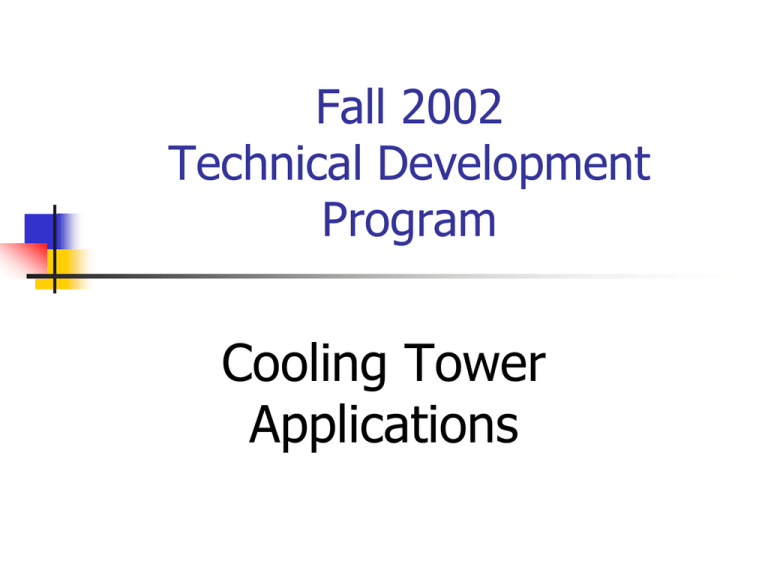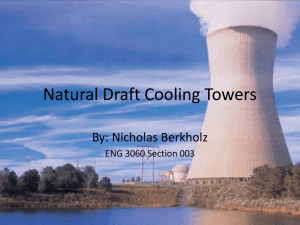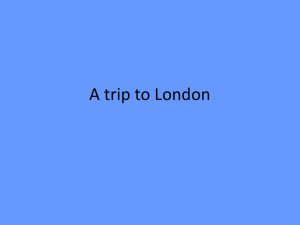TDP - Hawaii Building Engineers Association
advertisement

Fall 2002 Technical Development Program Cooling Tower Applications Heat Rejection How do cooling towers fit into an air conditioning system? A cooling tower is a heat transfer device. A cooling tower will reject heat from water that is circulated through a chillers shell & tube condenser. A shell & tube condenser is the refrigerant to water heat exchanger used in an open water circuit like a cooling tower. How Cooling Towers Work How Cooling Towers Work Warm water leaving the condenser is pumped to the top of the tower. This water is then distributed through spray nozzles or troughs through the wet deck surface (fill media) so that it may be brought in contact with outdoor air. This causes a small portion of the water to be evaporated. This evaporation removes heat from the remaining water. The cooled water collect is a sump at the bottom of the tower where it is returned to the condenser to pick up additional load and repeat the cycle. Definitions Entering Wet Bulb Temperature: The lowest temperature that water theoretically can reach by evaporation. Entering Wet Bulb Temperature Entering Wet-Bulb temperature is an extremely important parameter in tower selection and should selected for your specific climate zone in your exact location. Definitions Approach: The difference between the temperature of the entering wet- bulb temperature of the air and the cold water leaving the tower. Establishment of the approach fixes the operating temperature of the tower and is an important parameter in determining both tower size and cost. 7º approach is common in HVAC. Approach Approach Definitions Cooling Range: The difference in temperature between the hot water entering the tower and the cold water leaving the tower. 10º is Cooling Range is common in HVAC. Cooling Range Cooling Range Definitions Heat Load: The amount of heat to be removed from the circulating water within the tower. It is of primary importance that an accurate heat load determination be made. If the heat load calculations are low the cooling tower will be undersized. If the calculations are high, oversized more expensive equipment will result. Definitions Pumping Head: The pressure required to pump the water from the tower basin, through the entire system and return back to the top of the tower. 3GPM per Ton of Refrigeration Or 90GPM = approximately 30 ton tower Definitions Make-up: Is the amount of water required to replace normal losses caused by drift evaporation and bleed off. Make-up Water Definitions Drift: Water that is entrained in the airflow and discharged to the atmosphere approximately 2%. Drift loss does not include water lost by evaporation. Drift Definitions Evaporation: For each pound of water that a cooling tower evaporates, it removes somewhere near 1000BTU’s from the water that remains. The more evaporation that takes place, the more heat that is removed. Evaporation Definitions Bleed Off: Water contains impurities, when water is evaporated these impurities are left behind. If nothing is done about it, the concentration of impurities in would build up rapidly. Bleed off of some of the water is continuously required to limit this build up. The bleed off rate required is best determined by a water treatment specialist who is prepared to make the necessary tests and recommendations. Bleed Off Cooling Tower Design When air circulation is provided by a fan or blower the tower is called a mechanical draft tower. Induced draft: Draws air through the tower Force draft: Blows air through the tower. Cooling Tower Design Induced Draft Counterflow Cooling Tower Air goes up Water goes down Cooling Tower Design Induced Draft Crossflow Cooling Tower Air goes across Water goes down Cooling Tower Design Hyperbolic Natural Draft Counterflow Cooling Tower Cooling Tower Design Atmospheric Spray Tower Cooling Tower Design Forced Draft Counterflow Cooling Tower Application of Cooling Towers 1. When selecting the location, sufficient clearance should be allowed for the free Wind flow of air to the inlet of the tower and for its discharge from the tower. Obstructions will reduce airflow causing a reduction in capacity. Application of Cooling Towers 2. Cooling towers should be located so that noise created by air or water is not a source of annoyance. 3. Cooling tower location should be such that the air discharge will not cause Wind condensation on nearby surfaces or wetting because of drift. Water Noise Application of Cooling Towers 4. The tower should be located away from source of exhaust heat and contamination. Application of Cooling Towers 5. Each cooling tower should be located and positioned to prevent the introduction of the warm discharge air and the associated drift. This drift may contain chemical or biological contaminants including Legionella, which may get into the ventilation systems of the building on which the tower is located or those of adjacent buildings. To select a cooling tower, the following must be known Wet Bulb Temperature Cold Water Temperature (this is the year round environmental temperature for your exact location). (this is the desired water temperature to return to your condenser) Hot Water Temperature (the water temperature leaving your system) The Gallons Per Minute requirements of your system. To select a cooling tower, the following must be known Selection of design wet-bulb temperature must be made on the basis of conditions existing at the site proposed for a cooling tower, and should be that which will result in the optimum cold water temperature at, or near, the time of peak load demand. Cooling Tower Ratings Condenser Entering Water Temp 80.0 85.0 90.0 95.0 CAPACITY KW TONS INPUT 110.8 106.3 101.6 97.1 71.6 76.0 80.4 86.5 Based on 30HXC106 Screw Chiller, R134A 45F Leaving Chilled Water Temperature To select a cooling tower, the following must be known A wet bulb chart is arranged to show the summertime frequency of occurrence. Anaheim would have a 68 degree wet bulb that is exceeded .5% of summertime hours Generally, the designer engineer would select the design wet bulb for a specific installation, but some installations aren’t critical allowing the use of a reduced design values and smaller cooling towers. Other installations may work only in the winter or at night when the wet bulb temperature is low. The designer must select the design wet bulb for his/her project. When in doubt, select the highest anticipated wet bulb temperature to insure satisfactory year around operation. Cooling Tower Sizing Information EWT ___ 85 ___ 95 Leaving Water Temperature LWT ___ 75 ___ 85 Entering Wet Bulb (this is the year EWB ___ 68 ___ 78 GPM ___ 150 ___ 150 Entering Water Temperature (the hot water temperature leaving your shell and tube condenser and entering the cooling tower) (this is the desired cold water temperature to return to your shell and tube condenser) round environmental temperature for your exact location). The gallons per minute requirements of your system. (3 gallons per ton) Cooling Tower Model ___ ST80 ___ ST100 Cooling Tower Sizing Information Spending a little more for a tower with a VFD and last a little longer is almost always the wisest decision than selecting a tower that is too small. Cooling Tower Capacity Control Capacity of a cooling tower can be reduce by airflow thru the tower by using a on/off contactor or variable frequency drive (VFD). Temperature of the towers water basin can be used for operating the fan control. Condenser Temperature Control Three way valve For condenser temperature control on “Carrier Screw Chillers” a three way valve should be specified to maintain temperatures above Carriers minimum 70° water temperature for the condenser. The water loop between condenser and valve should be kept as small as possible so the water will heat up quickly. Condenser Temperature Control In conclusion Application checklist should include: Correct selection using actual Entering Wet Bulb Acceptable location on site Wet deck compatibility Piping (inlet, outlet, drain, make-up, overflow, support, equalizer) Capacity control Pan water freeze protection Sound







